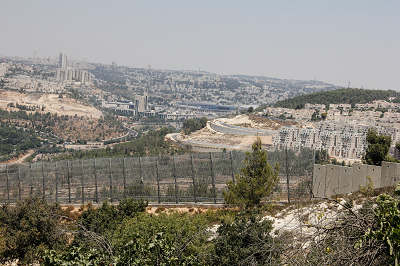Israeli occupation authorities on Tuesday stormed the village of al-Wallaja, near Bethlehem, to issue demolition orders to two homeowners who were in the midst of building on their family land.
Youth activist Ibrahim Awad Allah told the Palestinian Wafa News Agency that demolition crews from the Israeli municipality in the occupied city of Jerusalem, accompanied by a battalion of Israeli soldiers, stormed the village and went to the Joazh area to the north.
There, they delivered a notice to Palestinian homeowner Halima Ismail, ordering her to stop construction in her house, amounting to an area of 70 square meters; under the pretext of a lack of license.
Israeli authorities have refused, since 1967, to grant Palestinian homeowners permits to build on their land — instead allowing illegal Israeli settlements to take over Palestinian land, and transferring Israeli civilians to live in these settlements.
Ismail explained to local sources in the village that she was given the notice Tuesday, along with another Palestinian homeowner, Khaled Abu Gherkin, who had built a home on his land, along with his brother, after their previous home had been demolished by Israeli forces.
Abu Gherkin received a demolition notice on Tuesday, under the pretext of lack of license.
The village of Wallaja has, over a period of five years, been targeted by the Israeli occupation and a number of homes have been demolished, while other homeowners have been prevented from building on their land.
According to a report by the Applied Research Institute of Jerusalem, “ Since the displacement of Al-Walaja’s residents from their original home in Jerusalem during the war of 1948, about 100 out of 1600 villagers resettled on the adjacent hill. After the war of 1967, the Israeli government redrew Jerusalem’s boundaries, seizing a significant part of the village. The remaining Palestinian residents of Al-Walaja were subject to a prolonged process of restrictions limiting urban and demographic expansion. Until the Interim Agreement “Oslo II” in 1995, the village was classified into two areas: 3% “Area B” and 97.4 % “Area C”.
“Residents are allowed to develop and reside without prior military permission only within area “B.” Therefore, those in area “C,” which is fully controlled by the Israeli authorities, face constant threat of displacement. Moreover, Israel denies their right to live in the area that was seized in 1967. In 2006, the Israeli Civil Administration informed residents about the construction of the Separation Wall, which cuts the village off from its surrounding vicinity.
“As a result, they have suffered from land confiscations and house demolitions specifically within area “C.” This strategic plan aims at isolating the village as much as possible to annex the vacated land and expand the surrounding settlements “Gilo,” “Har Gilo,” and “Giva’at Yael.” “

